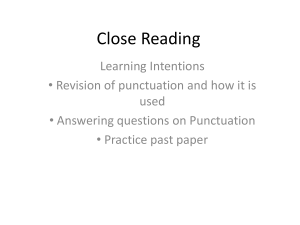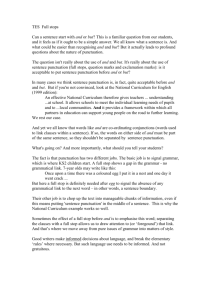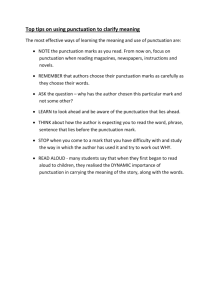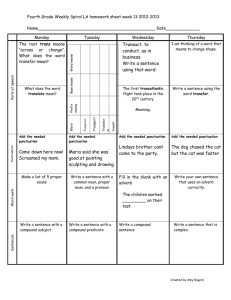View Sample Lesson in Word Format
advertisement
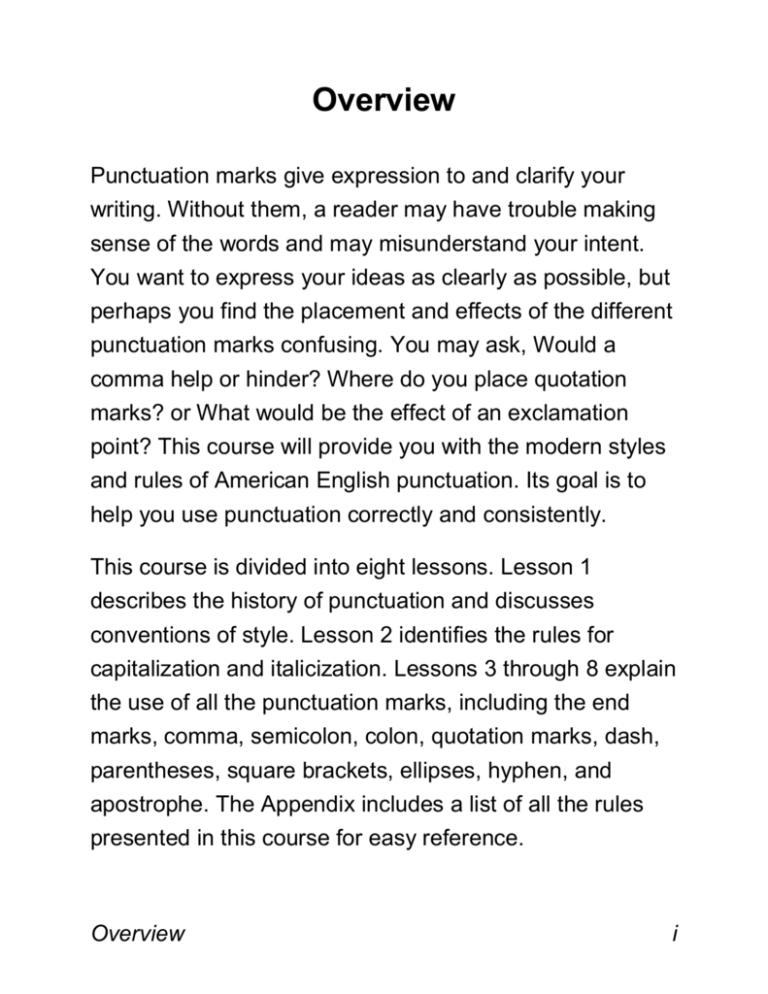
Overview Punctuation marks give expression to and clarify your writing. Without them, a reader may have trouble making sense of the words and may misunderstand your intent. You want to express your ideas as clearly as possible, but perhaps you find the placement and effects of the different punctuation marks confusing. You may ask, Would a comma help or hinder? Where do you place quotation marks? or What would be the effect of an exclamation point? This course will provide you with the modern styles and rules of American English punctuation. Its goal is to help you use punctuation correctly and consistently. This course is divided into eight lessons. Lesson 1 describes the history of punctuation and discusses conventions of style. Lesson 2 identifies the rules for capitalization and italicization. Lessons 3 through 8 explain the use of all the punctuation marks, including the end marks, comma, semicolon, colon, quotation marks, dash, parentheses, square brackets, ellipses, hyphen, and apostrophe. The Appendix includes a list of all the rules presented in this course for easy reference. Overview i You might already be familiar with the information presented in some of the lessons. Therefore, Lessons 2 through 8 begin with pretests that help you determine if you have enough knowledge to complete the assignment without reading the entire lesson. Answers follow each pretest. If you answer an entire pretest correctly, then you may consider proceeding directly to the assignment. Lessons 2 through 8 also include practice exercises. These help you apply the rules you have learned. Compare your answers with those that follow the exercise. For your convenience, each answer is followed by the applicable rule numbers in brackets. These pretests and practice exercises are for your personal development only, so do not send them to your Hadley instructor. You can always contact your instructor, however, to clarify items on these pretests or practice exercises. To complete the course, you are required to submit eight assignments, one at the end of each lesson. These assignments enable your instructor to measure your ability to apply the concepts presented in the lessons. Overview ii Now, if you’re ready to begin clarifying your writing with proper punctuation, begin Lesson 1: The Development and Styles of Punctuation. Overview iii Overview iv Lesson 1: The Development and Styles of Punctuation If punctuation didn’t exist, would written material make sense? Written texts without punctuation certainly would be very difficult to understand. How, then, did punctuation develop? This lesson describes the history of punctuation and discusses conventions of style. Outlining the history and styles of punctuation will help you understand the importance of using punctuation correctly and consistently. Objectives After completing this lesson, you will be able to a. b. briefly describe the development of punctuation discuss styles of punctuation A Short History of Punctuation Modern punctuation evolved slowly over the centuries. This section describes its historical development and shows how punctuation marks have been accepted among the world's languages. Language was spoken before it was written. In speech, pauses are expressed naturally. When telling a story, no Lesson 1: The Development and Styles of … 1 one says the word comma when the story calls for a pause, or period when an idea is complete. When language first was written, however, the reader had to guess where the pauses and breaks were. Indeed, readers in ancient times and the Middle Ages found it very difficult to understand texts due to the lack of punctuation marks. In ancient Greece, the preferred method of writing did not even allow spaces between words! Reading and comprehending were difficult tasks that only the best and most dedicated scholars could figure out. Punctuation includes spacing, marks, and typographic devices (e.g., enlarged, slanted, or underlined letters). The word punctuation comes from the Latin word punctus, which means “point.” The oldest Roman documents included points, or dots, in between words. Later texts indicated paragraphs by extending the first word out into the margin, which is the opposite of what is done today. The next development involved starting a new sentence with a gap and a larger first letter. Among Latin scholars and scribes, however, the practice of separating words did not become the rule. Lesson 1: The Development and Styles of … 2 In the seventh and eighth centuries, Latin texts were transcribed by German and Anglo-Saxon scribes, for whom Latin was a foreign language. They inserted spaces and marks to indicate paragraph and sentence endings, thereby showing they had understood the text. This development of punctuation enabled future scholars to read ancient texts. Can you imagine a world in which no one read silently? Until the tenth century, texts were always read aloud. The development of punctuation marks such as gaps, points, and enlarged letters that indicated breaks between words, sentences, and paragraphs, however, made silent reading possible. Punctuation continued to develop during the Middle Ages. Additions included marks that indicated inflection (i.e., changes in pitch or loudness), questions, and incomplete phrases. Many marks came from the musical notation of the time. As literacy increased after the invention of the printing press in the mid-fifteenth century, more people began to read silently. Authors then needed to insert familiar marks to indicate pauses and the sentence structures to readers. The printing process eventually standardized the various Lesson 1: The Development and Styles of … 3 marks authors and scribes used. That way, readers could count on a particular mark indicating the same thing among different works. Most of the marks used today were in use by the end of the sixteenth century. They did not, however, necessarily mean then what they do now in modern English. By the middle of the seventeenth century, the system of punctuation was complete. A space is always left between words, and uppercase letters start new sentences and indicate proper names and titles. English punctuation marks include the period, colon, semicolon, comma, parentheses, brackets, question mark, exclamation point, quotation marks, hyphen, and apostrophe. Other European languages use many of the marks used in English, although with some variations for quotations and emphasis. Spanish uses inverted question marks and exclamation points before the sentence as well as upright signs after the sentence. When Louis Braille devised the raised dot system for reading and writing, he included punctuation marks along with the letters of the alphabet. Lesson 1: The Development and Styles of … 4 Many of the European punctuation marks have been adopted in modern non-European languages as well. Printing and transcribing had much to do with the adoption. Hebrew, Arabic, Sanskrit, Chinese, and Japanese all use European punctuation marks, with variations, in modern printing. This section traced the historical development of punctuation. Isn't it interesting how the need for punctuation eventually led to a worldwide acceptance of the same marks? Style Rules Although the world uses many of the same punctuation marks, the rules for their usage may vary, even in the English language. This section discusses the importance of style rules and where you can find them. Punctuation marks themselves have changed little since the fifteenth-century printing presses began making books available to a wider audience. However, the style rules have changed with the times and thus have differed throughout history. Style rules define how punctuation marks are used correctly. Lesson 1: The Development and Styles of … 5 Style rules also differ among different languages and even among the various dialects of the same language. If you pick up a British or Canadian magazine, you may find commas where you would not expect to find them in an American magazine article. Even in standard American English, style may not be consistent from text to text. Also, different publications may follow different sets of style rules. Most book, magazine, journal, and newspaper publishers have their own style manuals, which set the punctuation rules for their publications. Often a publisher will require authors to follow an accepted style manual such as the Chicago Manual of Style or the Modern Language Association Style Manual. Hadley courses such as this very course, for example, generally follow the Chicago Manual of Style (15th edition). Style rules may differ among the various style manuals. In light of differing style rules, consistency becomes very important. For example, newspaper and magazine articles are carefully checked by copy editors for consistency with the chosen style manual. Literary authors may choose their own punctuation style as part of their artistic expression. In such a case, they choose to be consistent Lesson 1: The Development and Styles of … 6 with their own style. Whatever the chosen style, consistency is very important for clear punctuation and therefore, clear communication. Despite style differences, writing generally follows the basic punctuation conventions explained in this course. As you write, you can always check the list of rules that accompanies this course, or you might consult a style manual from the library or a bookstore, to make sure your punctuation is correct and consistent. Also, many dictionaries have a section on style that includes punctuation. Punctuation marks have largely remained the same, even among the different languages. Style rules, however, may vary even within the same language, as this section has shown. Therefore, consistency with the chosen set of style rules is very important for clear punctuation. Summary This lesson described the evolution of punctuation and explained style rules. It is useful to know that punctuation has a long history and continues to change today. You may have noticed the smiley face, which is a hollow circle Lesson 1: The Development and Styles of … 7 with dots for eyes and a large, curved line indicating a smile. Appearing in commercial and informal writing, the smiley face indicates something positive or funny. Perhaps it will evolve into a new punctuation mark! Lesson 1: The Development and Styles of … 8 Assignment 1 For general instructions on completing assignments, refer to the Welcome Letter. Then start this assignment by giving your full name, address, and phone number. Also list the name of this course, Assignment 1, your instructor’s name, and the date. Be sure to include the question number along with each answer. This assignment is worth 100 points. True/False Are the following statements true or false? If the statement is false, reword it to make it true. (3 points each, 30 points total) 1. When reading a text aloud, the speaker really should indicate pauses and breaks by saying “comma” and “period.” 2. The ancient Greeks invented punctuation. 3. Some ancient Greek documents used dots to indicate word breaks. 4. The printing process disrupted the punctuation system. Lesson 1: The Development and Styles of … 9 5. Louis Braille included punctuation marks in his system of raised dots. 6. Modern Hebrew uses punctuation marks similar to English punctuation marks. 7. Style rules vary among different languages, but not among American, British, and Canadian English. 8. All publishing companies in the United States follow the same style rules. 9. This course largely follows the Chicago Manual of Style. 10. Dictionaries are simply word references; they don't provide help with punctuation. Multiple Choice Answer the following multiple-choice questions by selecting the best answer: (5 points each, 25 points total) 11. Punctuation enabled people to a. speak their language b. read silently c. d. translate from other languages pray Lesson 1: The Development and Styles of … 10 12. The present system of punctuation was completed a. by the seventeenth century b. in the Middle Ages c. in ancient Rome d. in 1950 13. The rules for using punctuation marks a. b. c. d. haven't changed since the seventeenth century are exactly the same in all the style manuals have changed with the times apply only to writing that will be published 14. The best source for determining style rules is a. a dictionary b. c. d. a style manual an encyclopedia a newspaper or magazine 15. Which of the following statements concerning style rules is false? a. b. c. Style rules can differ within the same language. Style rules define how punctuation marks are used. Style rules change. Lesson 1: The Development and Styles of … 11 d. Style rules are used only by writers. Short Answer Briefly respond to the following items with complete sentences: (45 points total) 16. The early developments of punctuation enabled people to accomplish which two tasks? (10 points) 17. Briefly list six stages in the development of punctuation from the time of the Greeks to the middle of the seventeenth century. Hint: link each new development in punctuation with a specific historical period. (18 points) 18. Identify three ways punctuation style rules can differ from each other. (9 points) 19. What should you use to determine the correct usage of punctuation marks? (4 points) 20. What is very important to remember when using style rules for punctuation? (4 points) Once you have completed this assignment, send it to your instructor. Then proceed to Lesson 2: Capitalized and Italicized Letters. Lesson 1: The Development and Styles of … 12
